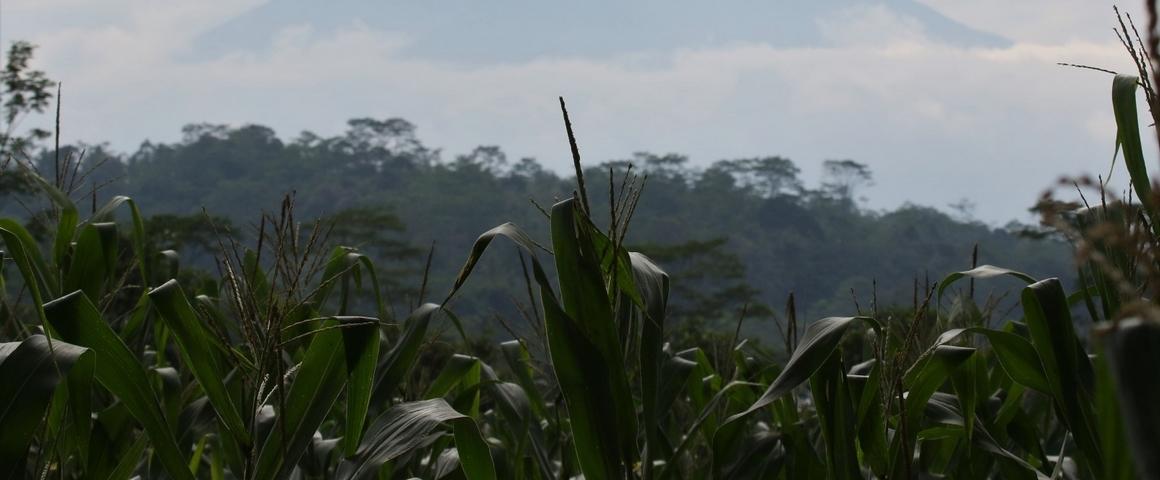Results & impact 10 October 2025
- Home
- Press area
- Press releases
- Bioenergy and land use
Bioenergy is not as good an idea as it seems if land use is overlooked

Maize is one of the main crops grown to produce bioenergy © A. Rival, CIRAD
The European Commission’s Fit for 55 plan aims to cut greenhouse gas (GHG) emissions by European Union member countries by 55% by 2030. To do so, the EU is counting on bioenergy, which would double demand for agricultural products, hence for arable land.
“The plan would force the EU to divert 20% of is cropland to energy crops”, says Patrice Dumas, an economist with CIRAD and co-author of an article published in Nature. “It would also lead to a fourfold increase in wood imports.”
Replacing agriculture for food production with agriculture for energy production across Europe would also mean importing more food crop products. Those crops would require more land, thus fostering deforestation outside the EU.
Scientists are therefore warning of the environmental consequences of the Fit for 55 plan if increased land use as a result of biomass fuel production is not incorporated into the accounting process. Those consequences include the loss of carbon storage within the EU and of biodiversity and forests outside the Union.
Bioenergy is not carbon-neutral
While bioenergy is undoubtedly greener than fossil fuels, the article’s authors point out that they are not carbon-neutral. Plants store carbon as they grow, which is released when biomass is burnt. However, land used for crops directly or indirectly replaces natural vegetation, which stores carbon.
That change in land use leads to losses, either as more natural vegetation is replaced, particularly through deforestation, or as less agricultural land is abandoned – land that would naturally be recolonized by vegetation. Likewise, primary forests contain much more carbon than the managed forests from which wood is taken.
The article therefore recommends caution as regards bioenergy crops. Tim Searchinger, a senior research scholar at Princeton University and lead author of the article, stresses that using land for bioenergy inevitably has a cost: “Land is not free. The plan sacrifices Europe’s great opportunity for a beneficial land future, one with more habitat, carbon storage and biodiversity in Europe. And one that eliminates Europe’s contribution to deforestation abroad."
Should we deforest elsewhere to grow energy and food crops?
One of the important points the study stresses is the increased deforestation outside the EU, particularly in the global South, to compensate for the lack of arable land and boost bioenergy production.
For instance, wood imports would increase fourfold by 2030. The plan would also trigger an increase in imports in agricultural products that would no longer be grown in Europe. Growing those crops would require land and push other parts of the world to deforest in order to make room for them. The plan would therefore contradict the EU’s proclaimed ambition of fighting imported deforestation.
What are the possible ways out?
The scientists make a series of recommendations in the article, including cutting meat consumption in Europe. They also say that taking account of the land carbon footprint of agricultural production would encourage intensification, to boost yields. "However, yields are already very high in Europe, with significant levels of nitrogen pollution and pesticide residues, which we should be working to reduce rather than increase."
Moreover, other renewable energies would seem to be more efficient than bioenergy derived from crops grown specifically, in terms of energy concentration and land carbon footprint. Bioenergy from agricultural residue and solar energy are two examples.
"Land carbon footprint is still a relatively new indicator and is often underestimated by decision makers", Patrice Dumas regrets. "To give just one example, the plan will result in the loss of half the semi-natural grassland in Europe, which house both a wealth of biodiversity and large quantities of carbon. This has not been taken into account, and it is a mistake."
The researchers stress that taking account of the land carbon footprint would serve to focus efforts on bioenergy produced in a sufficiently efficient way for the amount of fossil fuel replaced to offset the loss of carbon triggered by replacing the primary vegetation.
Reference
Timothy Searchinger, Oliver James, Patrice Dumas, Thomas Kastner & Stefan Wirsenius. 2022. EU climate plan sacrifices carbon storage and biodiversity for bioenergy. Nature



























